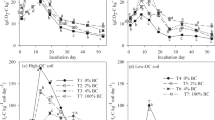Abstract
We studied in the laboratory the effects of acetylene (C2H2) concentrations on the accumulation and consumption of ethylene and methane in a temperate pine forest soil, and in situ ethylene and methane production and flush effects of nitrogen sources on both productions in the pine forest stand (Pinus sylvestris L.). The addition of C2H2 at concentrations more than 50 Pa C2H2 in the headspace caused a more than 95% reduction in rates of ethylene and methane consumption in forest soil compared to those with no C2H2. Furthermore, addition of acetylene within a range of 50 to 10, 000 Pa C2H2 induced a similar rate of methane accumulation in forest soil. Hence, it can be concluded that presence of more than 50 Pa C2H2 in the headspace is an effective method to measure methane production in forest soil. The addition of C2H2 at concentrations more than 50 Pa C2H2 induced an increasing concentration of ethylene in the headspace (P⩽0.05), indicating the reduction of acetylene to ethylene in forest soil. Using inhibition of 0.5 kPa C2H2 in combination with 5 kPa carbon monoxide that inhibits the reduction of acetylene in a short term, it was observed that there was a larger in situ methane production rate (218 ± 26 μg C m−2 h−1 (μg C per square meter per hour, the same below)) than in situ ethylene production rate (92 ± 6 μg C m−2 h−1) in the pine forest soil. The addition of nitrogen sources such as urea, urea plus a nitrification inhibitor dicyandiamide, and potassium nitrate, could induce a 5-fold greater increase in rates of in situ ethylene and methane production compared to those in the control, particularly in the latter (P⩽0.05). The results can promote in situ measurement of ethylene and methane production in forest soils at different sites.
Similar content being viewed by others
References
IPCC. In: Ehhalt D, Prather M, Dentener F, et al. eds. Atmospheric Chemistry and Greenhouse Gases. Cambridge: Cambridge University Press, 2001. 241–280
Prieme A, Christensen S. Seasonal and spatial variation of methane oxidation in a Danish spruce forest. Soil Biol Biochem, 1997, 29: 1165–1172
Schnell S, King G M. Mechanistic analysis of ammonium inhibition of atmospheric methane consumption in forest soils. Appl Environ Microbiol, 1994, 60: 3514–3521
Schnell S, King G M. Responses of methanotrophic activity in soil and cultures to water stress. Appl Environ Microbiol, 1996, 62: 3203–3209
Amaral J A, Knowles R. Inhibition of methane consumption in forest soils and pure cultures of methanotrophs by aqueous forest soil extracts. Soil Biol Biochem, 1997, 29: 1713–1720
Jäckel U, Schnell S, Conrad R. Microbial ethylene production and inhibition of methanotrophic activity in a deciduous forest soil. Soil Biol Biochem, 2004, 36: 835–840
Xu X K, Inubushi K. Production and consumption of ethylene in temperate volcanic forest surface soils. Eur J Soil Sci, 2007, 58: 668–679
Rigler E, Zechmeister-Boltenstern S. Oxidation of ethylene and methane in forest soils-effect of CO2 and mineral nitrogen. Geoderma, 1999, 90: 147–159
Wang Z P, Ineson P. Methane oxidation in a temperature coniferous forest soil: effects of inorganic N. Soil Biol Biochem, 2003, 35: 427–433
Xu X K, Inubushi K. Effects of N sources and methane concentrations on methane uptake potential of a typical coniferous forest and its adjacent orchard soil. Biol Fertil Soils, 2004, 40: 215–221
Inubushi K, Sugii H, Watanabe I, Wassmann R. Evaluation of methane oxidation in rice plant-soil system. Nutr Cycl Agroeco, 2002, 64: 71–77
Urmannk K, Gonzalez G G, Schroth M H, Hofer M, Zeyer J. New field method: gas push-pull test for the in-situ quantification of microbial activities in the vadose zone. Environ Sci Technol, 2005, 39: 304–310
Watanabe I, Hashimoto T, Shimoyama A. Methane-oxidizing activities and methanotrophic populations associated with wetland rice plants. Biol Fertil Soils, 1997, 24: 261–265
Pon G, Hyman M R, Semprini L. Acetylene inhibition of trichloroethene and vinyl chloride reductive dechlorination. Environ Sci Technol, 2003, 37: 3181–3188
Frankenberger W T, Arshad M. Phytohormones in Soils-Microbial Production and Function. New York: Marcel Dekker, 1995
Nohrstedt H. Natural formation of ethylene in forest soils and methods to correct results given by the acetylene-reduction assay. Soil Biol Biochem, 1983, 15: 281–286
Nohrstedt H. Carbon monoxide as an inhibitor of N2ase activity(C2H2) in control measurements of endogenous formation of ethylene by forest soils. Soil Biol Biochem, 1984, 16: 19–22
Hendrickson O Q. Implications of natural ethylene cycling processes for forest soil acetylene reduction assays. Can J Microbiol, 1989, 35: 713–718
Kim H T. Soil Sampling, Preparation and Analysis. New York: Marcel Dekker, 1995
Boer W D, Klein Gunnewiek PJA, Kester R A, et al. The effect of acetylene on N transformations in an acid oak-beech soil. Plant Soil, 1993, 149: 292–296
Sanhueza E, Dong Y, Scharffe D, et al. Carbon monoxide uptake by temperate forest soils: the effects of leaves and humus layers. Tellus Series B-Chem Phys Meteorol, 1998, 50: 51–58
Xu X K, Inubushi K. Effects of nitrogen sources and glucose on the consumption of ethylene and methane by temperate volcanic forest surface soils. Chin Sci Bull, 2007, 52: 3281–3291, doi: 10.1007/s11434-007-0499-z
Author information
Authors and Affiliations
Corresponding author
Additional information
Supported jointly by the National Natural Science Foundation of China (Grant Nos. 20477044 and 20777071), the Hundred Talents Project from the Chinese Academy of Sciences and by the Japan Society for the Promotion of Sciences
About this article
Cite this article
Xu, X., Inubushi, K. Measurement of ethylene and methane production in a temperate forest soil using inhibition of acetylene and carbon monoxide. Chin. Sci. Bull. 53, 1087–1093 (2008). https://doi.org/10.1007/s11434-008-0085-z
Received:
Accepted:
Published:
Issue Date:
DOI: https://doi.org/10.1007/s11434-008-0085-z




